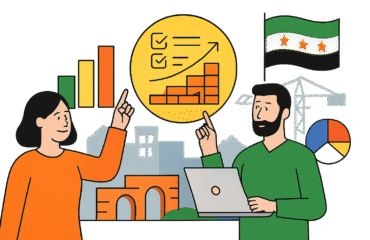
Singapore’s Strategic Vision: An Inspiring Success Story in Digital Transformation and Economic Prosperity
- Singapore’s strategic vision as an example of economic transformation and prosperity.
- The importance of long-term planning and good governance in Singapore’s success.
- Reliance on data as a fundamental element in decision-making.
- How Singapore uses data analysis in various sectors.
- Lessons learned for the Syrian context from Singapore’s experience.
Table of Contents
- Singapore’s Success Story
- Core Pillars of Singapore’s Strategic Vision
- Data Dependence in Decision-Making
- Singapore as a Global Financial and Commercial Center
- Lessons for the Syrian Context
Singapore’s Success Story
In a world where the pace of change is accelerating and the importance of data in decision-making is increasing, Singapore’s strategic vision emerges as a model to imitate in how to transform a small country with limited resources into a global financial and commercial center. Singapore’s success story of transforming from a country reliant on few natural resources to a global economic powerhouse is a testament to the power of long-term strategic planning, good governance, and heavy reliance on data in all decision-making. At “Insight Syria,” which specializes in in-depth case studies and data analysis, we see valuable lessons in the Singaporean experience that can be applied, albeit differently, in other contexts, including the Syrian context.
Core Pillars of Singapore’s Strategic Vision: Long-term Planning and Good Governance
Singapore’s journey to prosperity began after its separation from Malaysia in 1965, facing enormous challenges: a lack of natural resources, a fragile emerging economy, an unskilled workforce, and social tensions. Singapore’s leaders, headed by Lee Kuan Yew, had no choice but to set out a bold and long-term strategic vision. This vision was not merely immediate plans but a comprehensive roadmap aimed at building a strong and sustainable nation.
Long-term planning was the cornerstone of this vision. Instead of focusing on short-term solutions, Singapore set plans stretching over decades, relying on precise forecasts of global trends, accurate identification of local needs, and ongoing investment in infrastructure and education. This systematic approach allowed it to build new economic sectors such as high-tech manufacturing, financial services, and tourism, turning them into global centers in these fields.
As for good governance, it was an integral element of this strategy. Singapore relied on principles of transparency, accountability, integrity, and anti-corruption. This commitment to good governance built strong trust between the government and citizens, attracted foreign direct investments, and created a stable and secure business environment. Good governance was not just a slogan but a practical approach displayed in the efficiency of the government apparatus, the effectiveness of policies, and the ability to execute plans seriously.
Data Dependence in Decision-Making: The Backbone of Singapore’s Success
If long-term planning and good governance are the mastermind of Singapore’s success, then heavy reliance on data in all decision-making is the beating heart that fuels this strategy and ensures its success. Singapore realized early on that data is not just numbers but a key to understanding reality, predicting the future, and crafting the most effective policies.
From the early days, Singapore began systematically collecting data about its population, economy, and needs. Governmental bodies specialized in data collection and analysis were established, such as the Singapore Department of Statistics. It did not only collect government data but extended to encourage the private sector to collect and analyze data, creating a rich information ecosystem.
Data analysis in Singapore is not just a descriptive process but a foresight and directive process. Data is used to analyze population trends, predict labor market needs, evaluate the performance of different economic sectors, and identify areas that require investment in infrastructure or services.
In the education sector, data is used to assess the performance of schools and universities, identify areas for improvement, and guide students toward promising career paths. In the health sector, data is used to track disease spread, evaluate the effectiveness of health programs, and optimize resource allocation.
Application of data analysis in Singapore does not only cover traditional areas but extends to new and innovative fields. For example, big data is used in developing smart cities, improving traffic management, and enhancing public security.
Singapore as a Global Financial and Commercial Center: The Fruit of Planning and Data
Singapore could not have become a global financial and commercial center overnight. It is the result of decades of precise strategic planning, supportive economic policies, an attractive regulatory environment, and most importantly, continuous investment in infrastructure and reliance on data.
- Transition to a Financial Center: Singapore began building its financial center in the late 1960s and early 1970s, leveraging its geographical location and ability to attract foreign investments. By offering tax incentives, simplifying regulatory procedures, and developing a strong financial infrastructure, it was able to attract global banks and financial institutions.
- Trade and Logistics Hub: Thanks to its port, one of the busiest in the world, and its international airline network, Singapore has become a major hub for trade and logistics. Data analysis is used to improve the efficiency of logistics operations, reduce cargo transit time, and predict demand for logistics services.
- Innovation and Entrepreneurship: Singapore did not settle for just being a financial and commercial center but sought to be a hub for innovation and entrepreneurship. By supporting startups, providing the right environment for research and development, and investing in technology, it succeeded in building an innovation ecosystem.
- Human Capital Development: Singapore recognized that human capital is its most valuable resource. Therefore, it invested heavily in education and training, with a focus on developing the skills needed by the economy.
Lessons for the Syrian Context: Applying Strategic Vision Amid Challenges
At “Insight Syria,” we fully understand the challenges facing the Syrian society. Although circumstances differ, Singapore’s strategic vision offers lessons that can be inspired and applied, taking into account Syria’s specific context.
- The Importance of Long-term Vision: Even in difficult circumstances, it is essential to have a clear vision for the future. This vision must focus on capacity building, reconstruction, sustainable economic development, and enhancing human capital.
- The Need for Good Governance: Building strong and effective institutions characterized by transparency, accountability, and integrity is vital. Combating corruption, improving government service efficiency, and empowering citizens are essential elements to achieve stability and development.
- Reliance on Data in Decision-Making: In the reconstruction and development phase, data analysis will be an indispensable tool. Accurate data on needs, available resources, investment opportunities, and socio-economic challenges are needed.
- Investment in Education and Skill Development: Building a generation capable of facing future challenges requires significant investment in education and skill development.
- Encouraging Innovation and Entrepreneurship: To overcome reliance on traditional resources, innovation and entrepreneurship should be encouraged.
Frequently Asked Questions
What is Singapore’s strategic vision?
Singapore’s strategic vision is a bold and long-term plan to transform Singapore into a global financial and commercial center through long-term planning, good governance, and reliance on data.
How has reliance on data contributed to Singapore’s success?
Reliance on data has helped in making informed and quick decisions, analyzing economic trends, directing investments, thus allowing increased efficiency and growth.
What lessons can we learn in the Syrian context?
We can benefit from the importance of long-term vision, good governance, reliance on data, investment in education, and encouraging innovation and entrepreneurship.



